Ten Of The Best: Modular Software
We pick ten of the best modular software plugins on today’s market.
The explosion in popularity of modular gear in the last few years or so has been nothing short of astonishing. It’s gone from a rather specialist synthesis backwater to becoming a dominant force in electronic music. Much of its popularity is due to the spirit of experimentation that permeates it. Any number of synthesis types are available, and the way you set up and patch your system can have a huge affect on the sound that comes out.
Modular experimentation isn’t limited to the hardware world. There are a number of software-based modular environments for those that want to experiment “in the box,” or even create a hybrid physical/virtual setup. Here, we’d like to highlight 10 modular-style software programs that are worth looking into.
For the purposes of this roundup, we’re going to focus on software that allows for modular-type synthesis in a patchable environment, whether that be with traditional cable-type patching or arrangement of blocks or modules. We have extended the definition of “modular” to include semi-modular systems i.e. instruments that are capable of producing sound even before patching. While this wouldn’t fly in the real world, we think that broadening the definition will widen the possibilities. In the spirit of experimentation, we have also tried to include a number of different types of synthesis options in our selections.
As always, entries are listed in order of ascending price.
1
VCV Rack
https://vcvrack.com
?: Free
VCV’s Rack is an open-source Eurorack-emulating DAW that runs standalone on a number of computer platforms. For the Eurorack curious, it’s a great way to find out what the fuss is all about and see if Eurorack modular is indeed something you want to invest in.

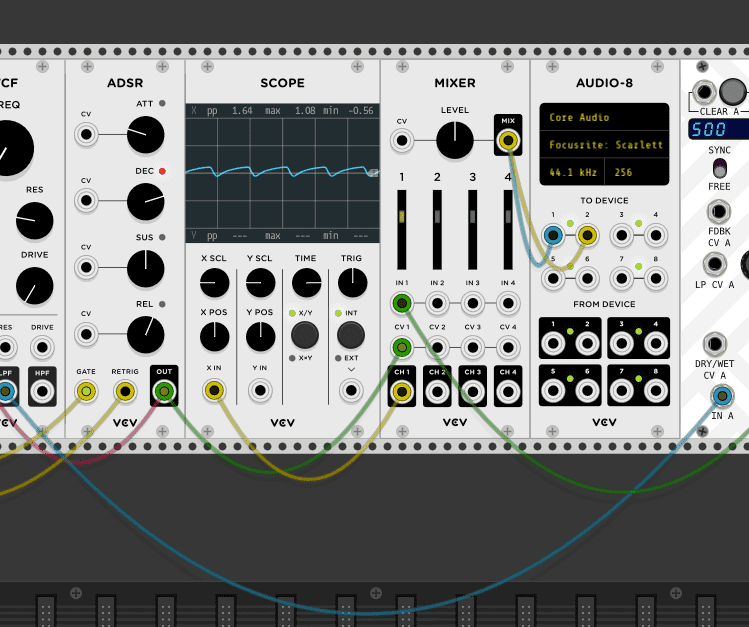 VCV Rack
VCV Rack
With VCV Rack, you get a big rack (no surprises there) and access to any number of modules with which you can populate it. Most modules are free and some require a modest payment. It’s all open-source, so as with Native Instruments’ Reaktor and other modular environments, there’s a lively development scene from which to pull instruments. Code is also available if you wish to jump into the deep end yourself. It’s as complicated as you want it to be—and when talking about Eurorack, things can get very complicated indeed.
VCV Rack is extremely flexible. Although it’s standalone-only it’s been designed to integrate with a number of other environments, including hardware Eurorack, Ableton via Ableton Link, and of course your DAW of choice with the appropriate internal audio router. It also sounds great.
If you’ve been wanting to explore what the world of Eurorack is all about, VCV Rack should be your first port of call.
2
Softube Modular
https://www.softube.com
? : $89
Softube’s Modular is a Eurorack-style modular environment for your DAW. Much like the previously mentioned VCV Rack or Cherry Audio Voltage Modular, it allows you to create large-scale Eurorack-style modular configurations. The selling point for Softube Modular, however, is its official emulations of popular gear. Softube collaborated with Doepfer, the creators of the Eurorack format, to create Modular, and seven of the German company’s classic modules come included, along with a number of other modules to get you started.
As you’d expect from Softube, the audio quality is excellent, with component-modeled recreations of some of the most famous Eurorack modules around, including Braids, Rings, and Clouds from Mutable Instruments as well as modules from Buchla and Intellijel. Softube has also made some of its popular effects plugins available as modules. Extra modules are not free but the price is usually much lower than the real thing.
If you’re interested in Eurorack but are intimidated by the cost, yet want to try working with authentic recreations of the real thing in your DAW, Softube Modular is a great place to start. It may be anathema to the hardcore, but having presets to hold your hand as you learn patching can be a life saver. And if you do take the plunge, Modular can interface with your hardware system as well.
3
Reason Studios Complex-1
https://www.reasonstudios.com
?: $99
It should come as a surprise to no one that Reason has a modular synthesizer. Reason Studios (formerly Propellerhead) were pioneers of virtual cabling. Reason V1.0, released way back in 2000, allowed users to freely attach patch cables around the back of the virtual studio “rack.” This has continued with Complex-1, an extremely flexible modular instrument that sounds absolutely incredible.
For those not familiar with the history of modular synths, Bob Moog and Don Buchla individually developed modular environments in the late 1960s. Moog’s, created on the East Coast of the United States, was made with traditional musicianship in mind, while Buchla’s West Coast synthesis favored experimentation. Both styles are represented in Complex-1, which features West Coast-style complex oscillators and low pass gates alongside a traditional filter and oscillator. Accompanying these are a waveshaper, noise generator, comb delay, and the usual clocks and multis. As with Reason on a whole, patch cables can be rendered invisible for easier knob tweaking.
If you’re a Reason user and you’ve been pining to try your hand at modular, Complex-1 is a wonderful-sounding way to get started. It’s complex (as the name suggests) yet its compact size keeps things from becoming overwhelming. And it really does sound gorgeous—so much so that users of Ableton or Logic might want to think about getting Reason and using Complex-1 as a plugin.
4
Air Music Technology Loom II
https://www.airmusictech.com
?: £101.98
So far, the modular-style software we’ve looked at has been of the traditional patch cable variety but this is not the only way that we can think about modular. Air Music Technology’s Loom II plugin is also a modular synthesizer, yet not one that is immediately recognizable as such.

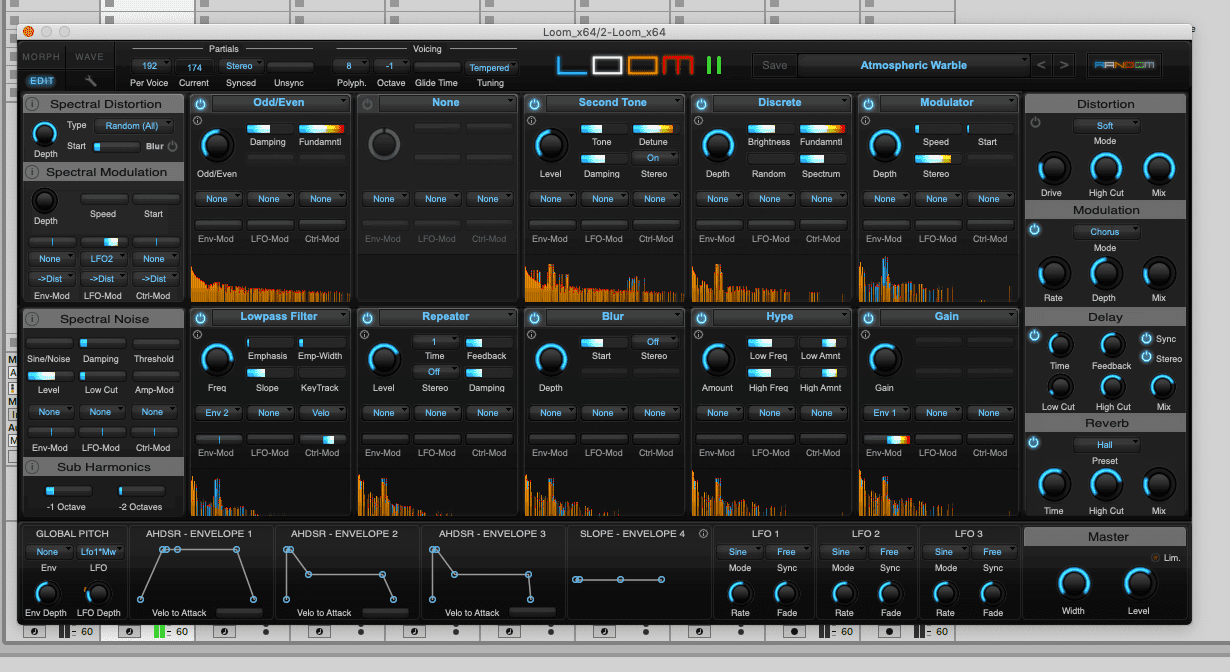 Air Music Technology Loom II
Air Music Technology Loom II
Loom II is an additive synthesizer, meaning that sound creation is handled by (you guessed it) adding harmonic partials rather than subtracting them, as with a traditional analogue synthesizer. Organs use a primitive kind of analogue additive synthesis. Loom II, which is digital, is anything but primitive, using up to 512 harmonic partials per patch. This allows you to create pretty much any sound you can imagine, from bass to pads, but it excels in evolving textures and atmospheres.
So how is it “modular”? Sound design is handled in a modular way, with up to 10 spaces available to hold one of 34 editable “modules.” These are for everything from sound generation, filtering, effects, and more. Modulation is a key component to Loom II so there are lots of ways to get sound moving as well. Although this is a complicated instrument using a type of synthesis that not many are familiar with, it’s intuitive to use and extremely rewarding. And it sounds just gorgeous.
5
Madrona Labs Kaivo
https://madronalabs.com
?: $129
One of the knock-on effects of the popularity of Eurorack modular in recent years is a healthy interest in less common kinds of synthesis. Wavetable, additive, and of course West Coast synthesis have all gotten boosts in popularity thanks to the “anything goes” spirit of modular experimentation. Another type of synthesis that has recently gotten some press is physical modeling, a somewhat esoteric form that aims to emulate the physical properties of acoustic instruments.

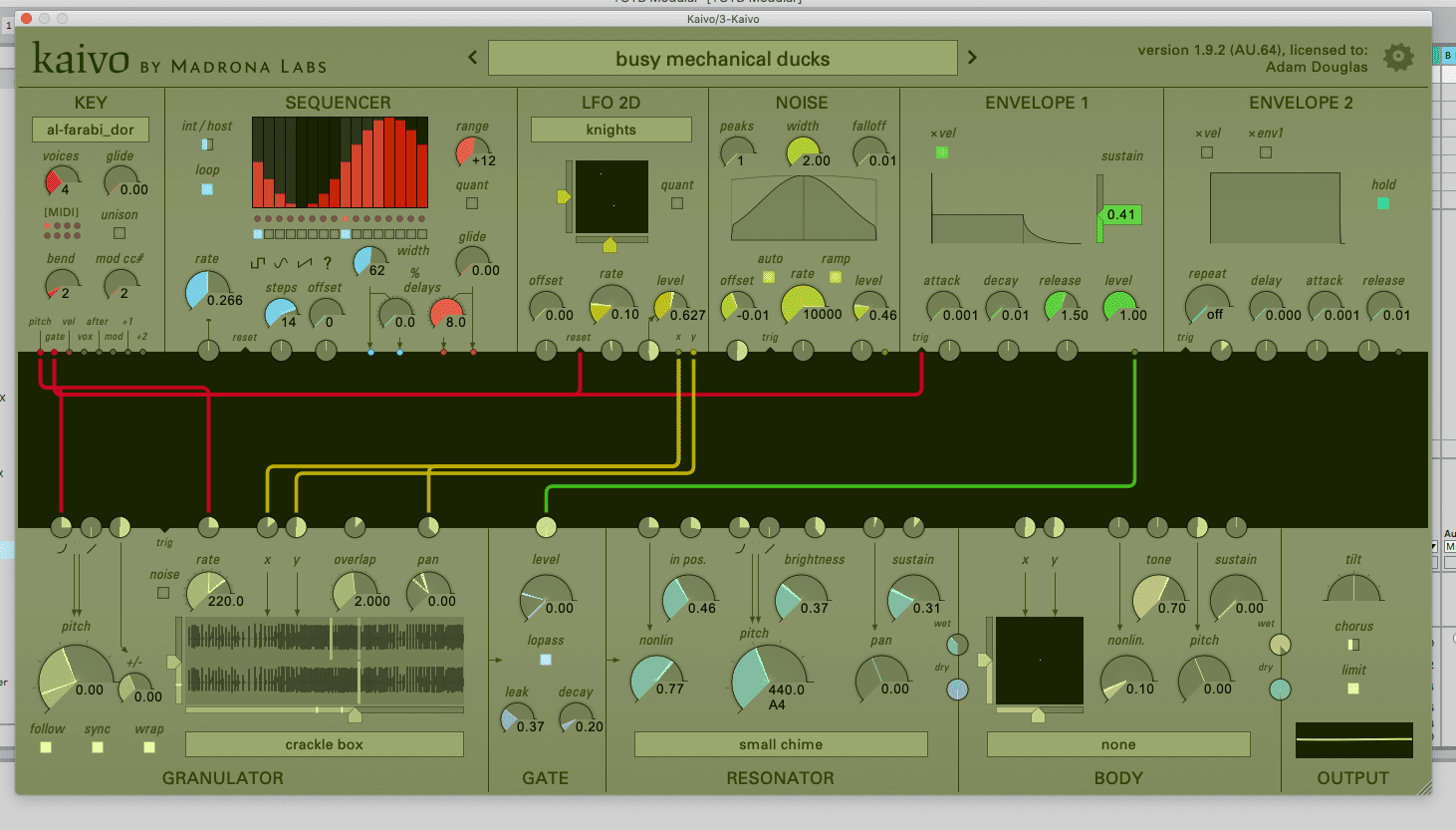 Madrona Labs Kaivo
Madrona Labs Kaivo
Madrona Lab’s excellent Kaivo starts with physical modeling and adds granular synthesis to the mix, resulting in an instrument that is capable of making a lot of sounds that you just don’t hear other synths making. The sound begins with the granulator, a granular synthesis player that allows for more esoteric sound generation than your usual physical modeling synth. Next, it passes through a resonator, usually a string or bell, and then goes into the body of the virtual instrument, like a box or metal plate. The semi-modular environment allows all of these things to be modulated, and it can get complicated and freaky very quickly.
Kaivo is an utterly unique instrument that rewards patience and experimentation. It is a sound designer’s dream, and with its patching functionality, things can really be taken to extremes. It likely won’t be your everyday go-to synth but if you’re looking for something a bit more left field, Kaivo will not disappoint.
6
u-he Bazille
https://u-he.com
?: €129
We’re big fans of u-he here at Attack HQ. Their instruments and effects are consistently stellar with a richness and depth to the sound that beggars belief. So you won’t be surprised to learn that we absolutely love Bazille too.
Bazille is u-he’s top-shelf modular synth, a patchable polyphonic instrument with (surprisingly) digital oscillators. And not just any old digital oscillator, but phase distortion, originally made popular by Casio in the 1980s with its CZ line of synths, and FM, which ruled the roost in the Thatcher-era and is making something of a comeback today. While this might seem like a recipe for harshness, the sound is balanced out by analogue-style multimode filters. The result is as smooth and rich as you would expect from u-he. As befitting a modular-style synth, it also has the usual useful selection of multis (for combining signals), envelopes, and LFOs, with all oscillators available to be used as LFOs as well. A sequencer rounds things out.

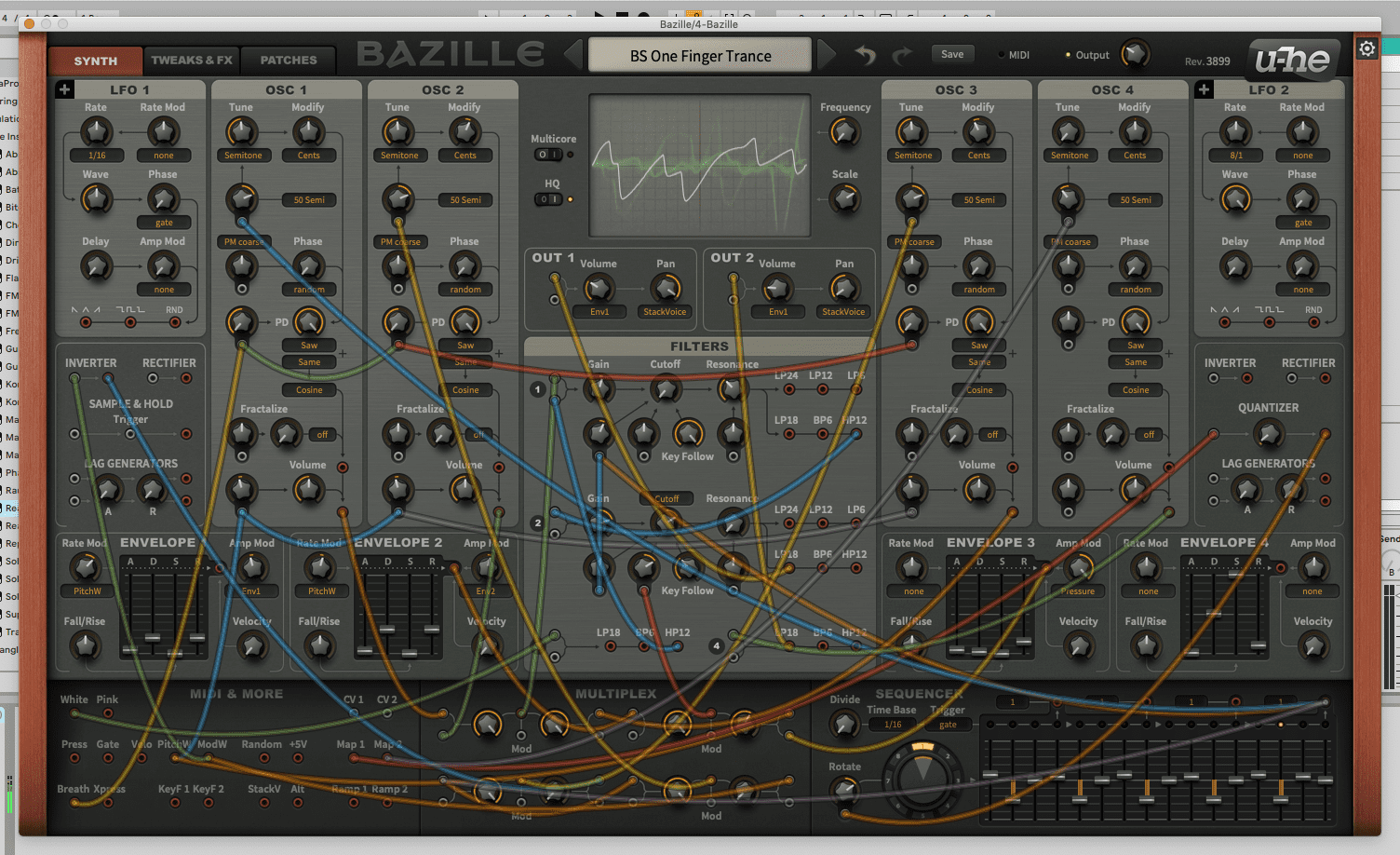 u-he Bazille
u-he Bazille
With plenty of extra features hiding behind panels, Bazille can be as complicated and expressive as you need it to be. It can handle bread and butter sounds like bass just as well as more experimental patches. The fact that its oscillators are digital also sets it apart from other, similar modular-style synthesizers. There’s a clean sheen to the sound that is very inspiring. Classic yet modern: that’s Bazille.
7
Arturia Buchla Easel
https://www.arturia.com
?: €74
Let’s get esoteric. The Buchla Music Easel is to West Coast synthesis as the Moog Minimoog is to East Coast. Originally released in 1973, it was a portable instrument capable of achieving synthesis similar to a full-on Buchla modular system, although in a much more simplified form. Somewhat unusually for a Buchla, it had a chromatic keyboard, albeit one in touch plate form. It was recently re-released by Buchla but it’s not what you’d call cheap, so if you’re at all interested in this famous machine, Arturia’s meticulously recreated version, the Buchla Easel V, is where you should turn.
What’s initially shocking about using the Buchla Easel V is how unfamiliar it feels, even for seasoned synthesizer pros. That’s because West Coast synthesis is very different from what we’re used to. This not a bad thing though. West Coast synthesis is all about experimentation, and when you’re coming at an instrument fresh, you’re bound to create something you normally would have not.

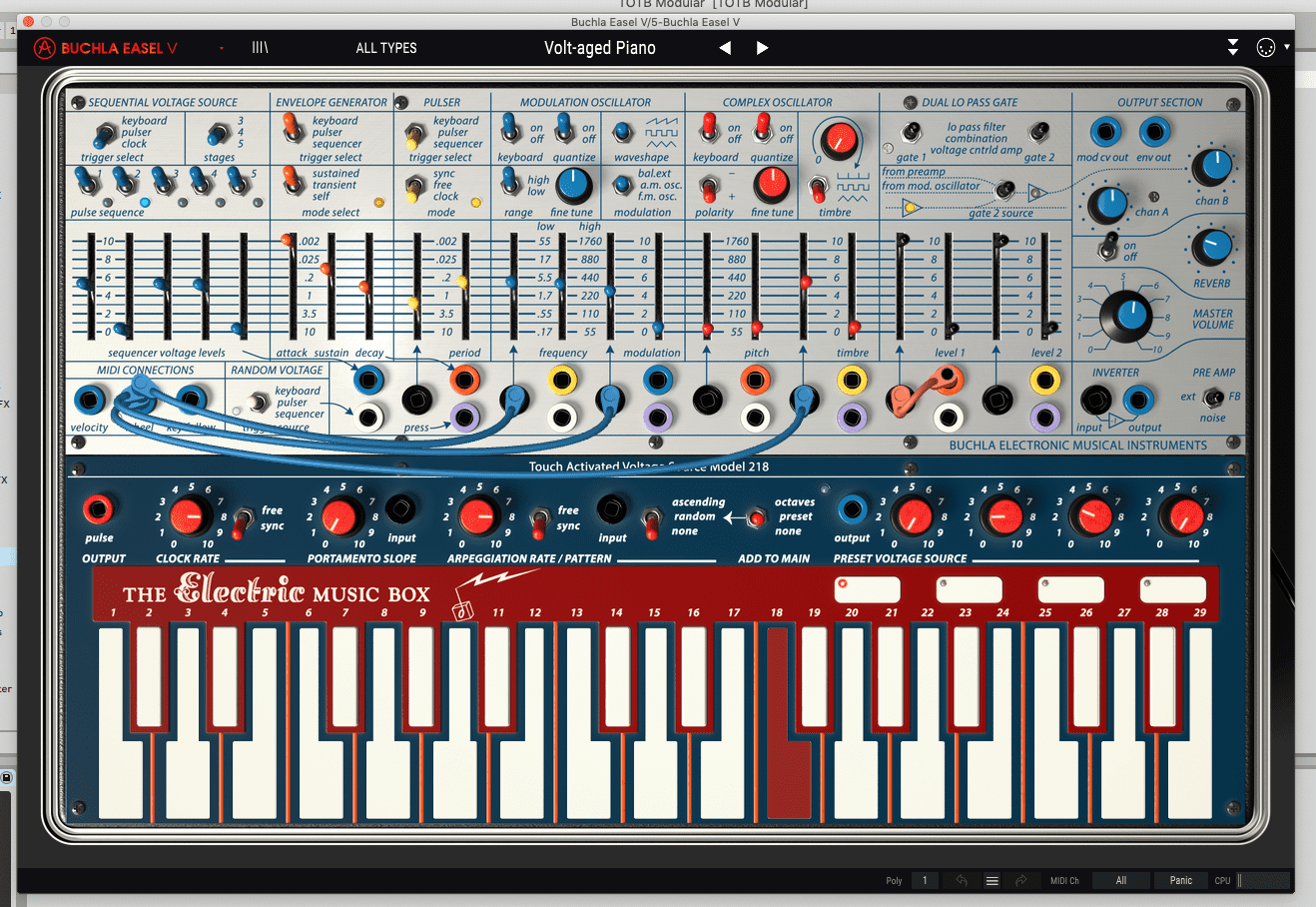 Arturia Buchla Easel V
Arturia Buchla Easel V
Thankfully, spend a little bit of time and get your head around the controls and colours, and you’ll soon be bleeping and blooping like the best of them. We joke, but it should be noted that, with a little coaxing, the Easel is capable of making some of your typical bass and pad sounds. However, you’re better off thinking of this as a chemistry lab well-stocked with colorful concoctions to mix up. Part of the fun is seeing what happens. Sometimes you get a bunch of smoke, and sometimes you get angels singing down from heaven.
8
Cherry Audio Voltage Modular
https://cherryaudio.com
?: $150
Much like VCV Rack and Softube Modular, Cherry Audio’s Voltage Modular is a Eurorack-style virtual modular system. It can work as a plugin or standalone, and can be filled up with a number of expander modules. Modules can be purchased from inside the software and are soon made available for patching, and those who wish to try designing their own modules can do so and submit them to the store.

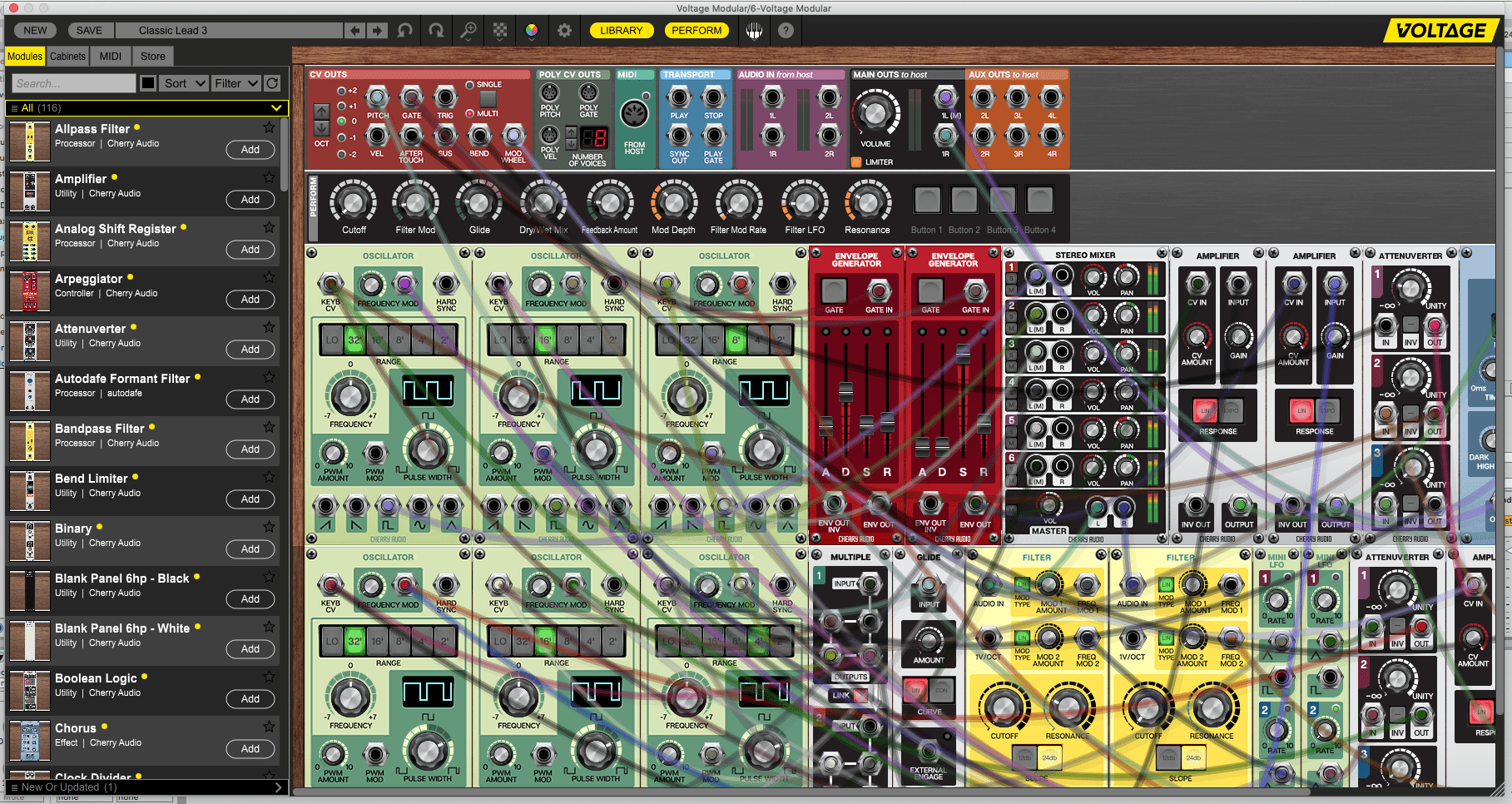 Cherry Audio Voltage Modular
Cherry Audio Voltage Modular
Voltage Modular also sounds amazing, with 64-bit audio processing throughout. Cherry Audio’s analogue oscillators use an alias-free algorithm, and the analogue filters model the kinds of minor distortions you get with hardware filters. Add to this MIDI controllability from your DAW, unlimited instances of modules, and patch-saving, and it’s easy to see the attractiveness of this virtual rack.
While Cherry Audio offers a couple of price points, we’re recommending the Core system, which comes bundled with the Electro Drums pack. This is a great starting point for creating the kinds of full rhythmic, evolving sequences that Eurorack has become known for. Happy patching.
Read our review here.
9
Kilohearts Phase Plant
https://kilohearts.com
?: $169
One of the key points of modular synthesis is experimentation. With so many different sound generators and modulation sources to choose from, the ability to craft as-of-yet unheard sounds is a very real possibility. And yet sometimes large modular systems can be unwieldy and a little intimidating. What if you could have all the experimental power of a modular in a more controllable synthesis package?
![]()
 Kilohearts Phase Plant
Kilohearts Phase Plant
Enter Phase Plant from Kilohearts. Don’t look for patch cables; this modular synth has blocks that can inserted in lanes, and can be as simple—or complex—as required. Start with a generator. This sound source can be an analogue oscillator, sample, or wavetable. Next choose your modulators (LFOs and envelopes) and effects, of which there is a ridiculous amount. There are also macros and everything else you might expect from a modern synthesizer plugin.
Phase Plant has a monster sound, and is especially good at tearing bass and (as you might expect) evolving pads and effects. It is particularly suited to electronic music production, with plenty of riser and effect presets alongside the usual keys and leads.
If you’re looking for a synth to handle modern sound design duties and you also enjoy the experimentation that working in a modular environment brings, this is the synth for you.
10
Native Instruments Reaktor 6
https://www.native-instruments.com
?: $199
And so we arrive at Reaktor, the daddy of them all. Native Instruments’ pioneering modular software environment is a high-water mark in music software, period. First released in 1996 under the name Generator, Reaktor is now up to version 6 and shows no signs of slowing down. A complete synthesizer development platform, Reaktor gives users the power to design their own synthesizers and effects units. These can then be shared with other users, resulting in thousands of instruments available online.

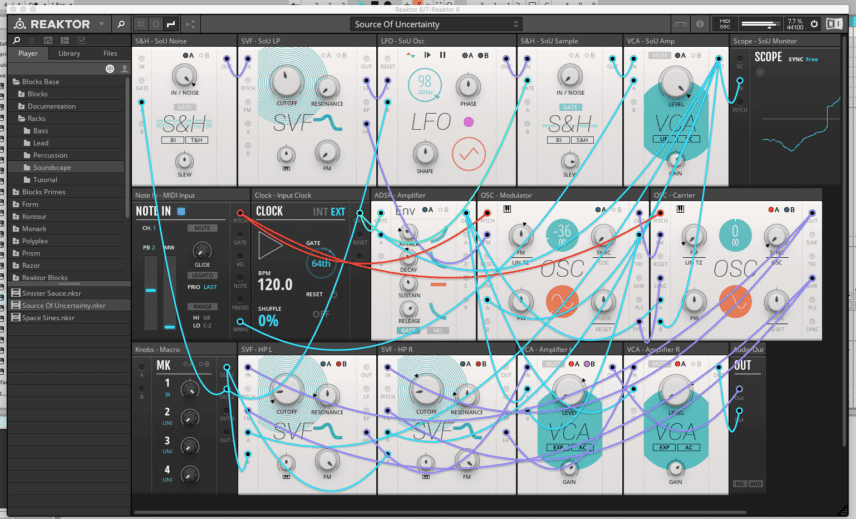 NI Reaktor
NI Reaktor
Reaktor 6 continues to push boundaries with Blocks, its own Eurorack-style modular system. Housed inside Reaktor, Blocks lets you connect different modules of varying kinds to create basically sound you can imagine. Block units come from NI themselves (sometimes pulling code from older synths like Monark and Massive) as well as from other developers. Everything you would expect for a modular system—oscillators, filters, multis, clocks—are here, with both West and East Coast synthesis represented.
As you would expect from Native Instruments, the sound quality is shockingly good. Even if you’re not interested in building a mammoth Richard Devine-style self-generating system and just want a nice bass or lead sound, Reaktor Bocks is a great way to get that tone.
Yes, Reaktor is a bit on the expensive side, but remember: you’re not getting just a synth; you’re getting an entire world. Essential, no matter what kind of music you make.
*Attack Magazine is supported by its audience. When you purchase through links on our site, we may earn an affiliate commission. Learn more.
Mục lục bài viết
Related
6th May, 2020











